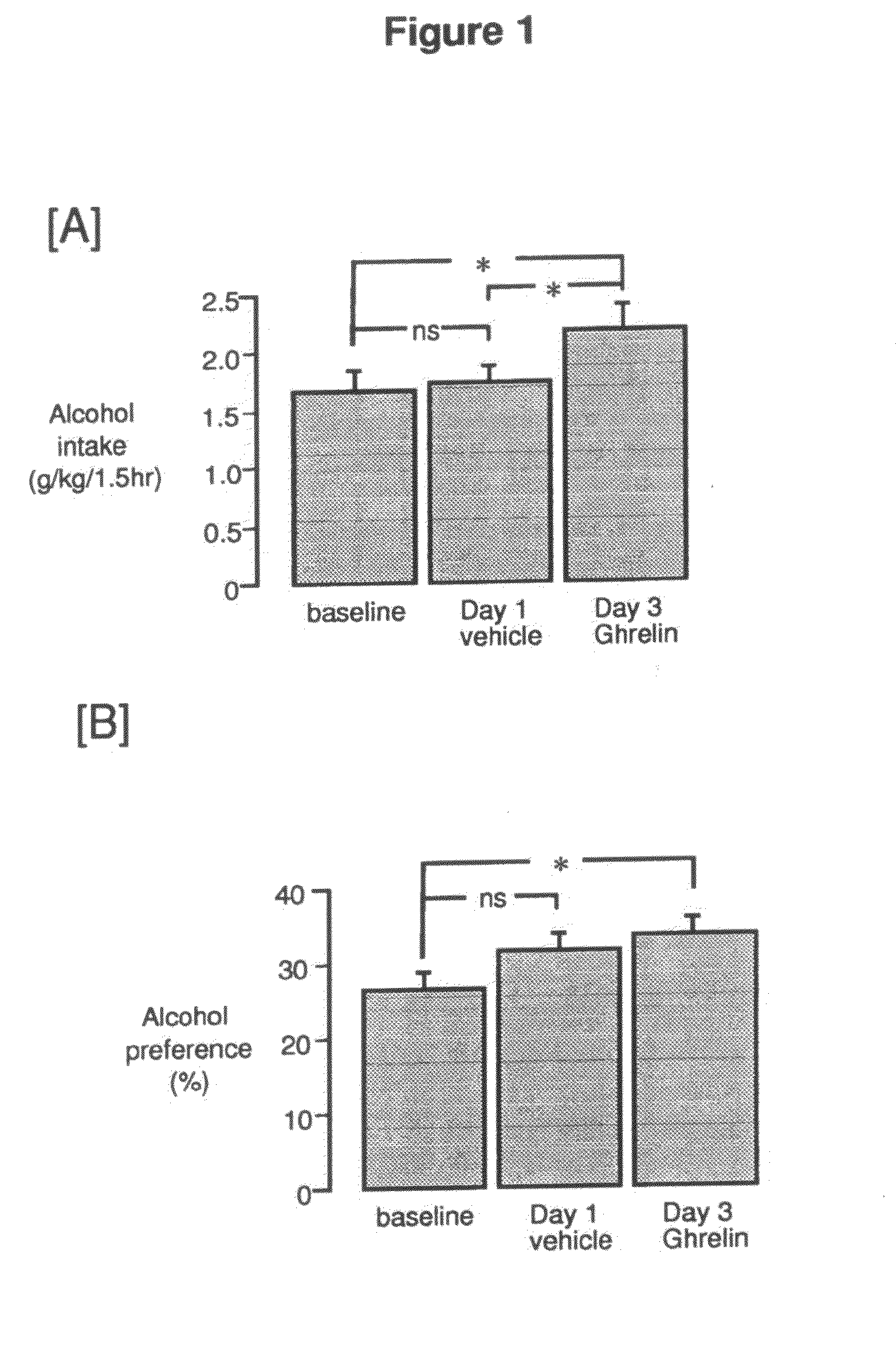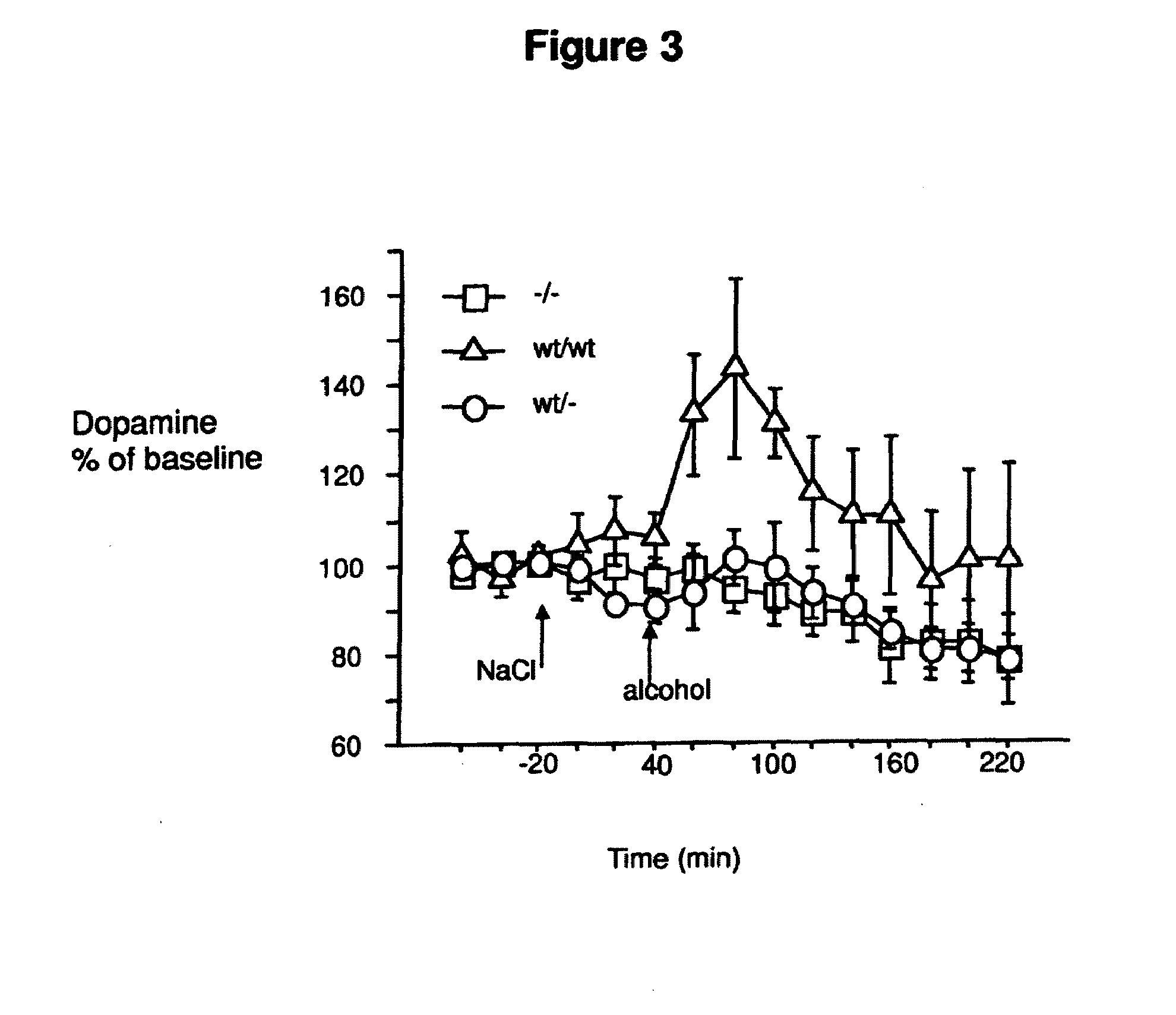Treament for chemical substance addiction
- Summary
- Abstract
- Description
- Claims
- Application Information
AI Technical Summary
Benefits of technology
Problems solved by technology
Method used
Image
Examples
example 1
Radiolabeled Ligand Competition Binding Assay
[0736]Ghrelin binding assays are performed with membrane preparations. CHO-K cells expressing human ghrelin receptor (GHS-R1A) (PerkinElmer) are suspended in sucrose buffer (0.25 M sucrose, 10 mM Hepes pH 7.4, 1 mM PMSF, 5 μg / ml pepstain-A, 3 mM EDTA and 0.025% bacitracin) and disrupted by sonication using e.g. a vibra cell (Sonics and Materials Inc.) on 70% duty cycle in 15-second pulses on ice for 2.5 min. The homogenate is centrifuged at 60,000×g for 60 minutes and pellets are suspended in Tris buffer (20 mM Tris pH 7.4, 5 μg / ml pepstatin-A, 0.1 mM PMSF and 3 mM EDTA).
[0737]Binding reactions should contain ˜1 μg membrane as determined by BCA protein assay (Pierce), 0.1 nM [125I]-ghrelin (PerkinElmer) with or without compound addition in 100 μl of binding buffer (25 mM Hepes pH 7.4, 1 mM CaCl2, 5 mM MgSO4 and 0.5% protease free BSA). Incubations are carried out at room temperature for 2 hr and are terminated by filtration using e.g. a F...
example 2
[0739]The ghrelin receptor signals constitutively through the phospholipase C pathway as determined in spontaneous, ligand-independent stimulation of inositol phosphate turnover. In order to study the ligand independent, spontaneous activity of the ghrelin receptor changes in phospholipase C activity as measured by inositol phosphate turnover is determined in cells transiently transfected with the ghrelin receptor. This method is further used to characterize compounds that can act as ghrelin receptor inverse agonists (GHS-RIA) and ghrelin receptor partial agonists (GHS-RPA).
Material and Methods
Compounds
[0740]Ghrelin and [D-Arg1, D-Phe5, D-Trp7,9, Leu11]-Substance P can be purchased from Bachem (Bubendorf, Switzerland).
[0741]The human ghrelin receptor (GHS-R1A) cDNA (GenBank accession no U60179) can be cloned by PCR from a human brain cDNA library. The cDNA is cloned into a eukaryotic expression vector, e.g. pcDNA3 (Invitrogen, Carlsbad, Ca...
example 3
[0751]The ghrelin receptor signals constitutively through multiple intracellular pathways as illustrated by the cAMP responsive element (CRE) and the factor of activated T cell (NFAT) gene transcription pathways. The present example can be used to demonstrate that the ghrelin receptor signals constitutively through the downstream cAMP responsive element (CRE) pathway (conceivably activated through some intermediate kinase pathway). In fact the high constitutive signalling activity of the ghrelin receptor can be detected in multiple intracellular signalling pathways. In the present example this is further substantiated by measuring the factor of activated T cell (NFAT) gene transcriptional activity in a reporter assay.
Material and Methods
[0752](for general molecular pharmacological methods etc. see Example nr. 2)
CRE and NFAT Reporter Assay.
[0753]In both reporter assays HEK293 cells (30 000 cells / well) seeded in 96-well plates are transiently transfected. Th...
PUM
| Property | Measurement | Unit |
|---|---|---|
| Disorder | aaaaa | aaaaa |
Abstract
Description
Claims
Application Information
 Login to View More
Login to View More - R&D
- Intellectual Property
- Life Sciences
- Materials
- Tech Scout
- Unparalleled Data Quality
- Higher Quality Content
- 60% Fewer Hallucinations
Browse by: Latest US Patents, China's latest patents, Technical Efficacy Thesaurus, Application Domain, Technology Topic, Popular Technical Reports.
© 2025 PatSnap. All rights reserved.Legal|Privacy policy|Modern Slavery Act Transparency Statement|Sitemap|About US| Contact US: help@patsnap.com



